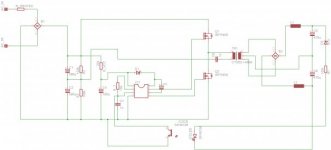Recently, I built simple SMPS based on IR2153. This is first time i'm making isolated SMPS.
It's nothing more than circuit from Ir2153-s datasheet with addition of optocoupler+zener for output regulation.
It's designed to deliver +/- 50V for amplifier, with regulation, so peak voltage should be arround 66V.
First, I tested circuit without regualtion circuit, and it worked perfectly right away. Then, I connected regulation circuit as well, and it still worked somewhat fine, except for somewhat assymetrical DC output voltage.
To do some further experiments, I disconnected 1 optocouplers pin, and left 2 wires on my protoboard, so that I can connect and disconnect optocoupler when needed.
This is where issues started - after touching those 2 wires (turning regulation on) few times in a row, circuit just died - output voltage is pretty much 0V. I measured IC's supply voltage and it was arround 8,4V.
I was pretty shure that I just somehow fryed IC while probing MOSFET gates with scope, so I replaced my IC with new one.
Then, I turned regulation on again, by touching 2 wires, and IC died again. IC's supply voltage is arround 8,4V again.
Finaly, I probed IR2153-s pin 3 with scope, as well as MOSFET's gates, and it seems that IC is oscillating!?
Is there any reason why this should happen?
I even disconnected low side FET, to make shure that he's not puling down supply voltage someho.
It's nothing more than circuit from Ir2153-s datasheet with addition of optocoupler+zener for output regulation.
It's designed to deliver +/- 50V for amplifier, with regulation, so peak voltage should be arround 66V.
First, I tested circuit without regualtion circuit, and it worked perfectly right away. Then, I connected regulation circuit as well, and it still worked somewhat fine, except for somewhat assymetrical DC output voltage.
To do some further experiments, I disconnected 1 optocouplers pin, and left 2 wires on my protoboard, so that I can connect and disconnect optocoupler when needed.
This is where issues started - after touching those 2 wires (turning regulation on) few times in a row, circuit just died - output voltage is pretty much 0V. I measured IC's supply voltage and it was arround 8,4V.
I was pretty shure that I just somehow fryed IC while probing MOSFET gates with scope, so I replaced my IC with new one.
Then, I turned regulation on again, by touching 2 wires, and IC died again. IC's supply voltage is arround 8,4V again.
Finaly, I probed IR2153-s pin 3 with scope, as well as MOSFET's gates, and it seems that IC is oscillating!?
Is there any reason why this should happen?
I even disconnected low side FET, to make shure that he's not puling down supply voltage someho.

